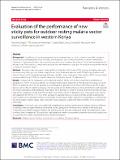| dc.description.abstract | Surveillance of outdoor resting malaria vector populations is crucial to monitor possible changes in vector resting and feeding behaviour following the widespread use of indoor-based vector control interventions. However, it is seldom included in the routine vector surveillance system in Africa due to lack of well standardized and efficient traps. This study was conducted to evaluate the performance of sticky pots for outdoor resting malaria vector surveillance in western Kenya. Methods: Mosquito collections were conducted from September 2015 to April 2016 in Ahero and Iguhu sites, western Kenya using sticky pots, pit shelters, clay pots, exit traps, Prokopack aspirator and CDC light traps (outdoor and indoor). Species within Anopheles gambiae (s.l.) were identified using polymerase chain reaction (PCR). Enzyme-linked immunosorbent assay (ELISA) was used to determine blood meal sources of malaria vectors. Results: A total of 23,772 mosquitoes were collected, of which 13,054 were female anophelines comprising An. gambiae (s.l.) (72.9%), An. funestus (13.2%), An. coustani (8.0%) and An. pharoensis (5.9%). Based on PCR assay (n = 672), 98.6% An. arabiensis and 1.4% An. gambiae (s.s.) constituted An. gambiae (s.l.) in Ahero, while this was 87.2% An. gambiae (s.s.) and 12.8% An. arabiensis in Iguhu. The sticky pots and pit shelters showed similar performance with regard to the relative abundance and host blood meal indices of An. gambiae (s.l.) and An. funestus. In terms of density per trap, a pit shelter caught on average 4.02 (95% CI: 3.06-5.27) times as many An. gambiae (s.l.) as a sticky pot, while a sticky pot captured 1.60 (95% CI: 1.19-2.12) times as many An. gambiae (s.l.) as a clay pot. Exit traps yielded a significantly lower number of An. gambiae (s.l.) than all other traps in Ahero, but a higher number of An. gambiae (s.l.) compared to the other outdoor traps in Iguhu. Indoor CDC light traps captured a significantly higher number of An. funestus than other traps. Conclusions: Sticky pots could be a useful and complementary tool for outdoor resting malaria vector surveillance, in settings where using pit shelters is not feasible and less productive. The lower vector density in the sticky pots compared to pit shelters suggests that batches of sticky pots (i.e. four per compound) need to be deployed in order to make a direct comparison. This study also highlighted the need to concurrently undertake indoor and outdoor vector surveillance to better understand residual malaria transmission. | en_US |

